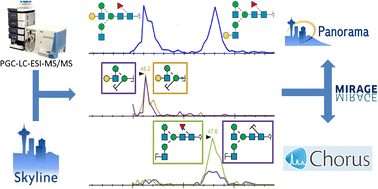Discrimination of Isomers of Released <Emphasis Type="Italic">N-</Emphasis> and <Emphasis Type="Italic">O-</Emphasis>Glycans Using Diagnostic Product Ions in Negative Ion PGC-LC-ESI-MS/MS |
| |
| Authors: | Christopher Ashwood Chi-Hung Lin Morten Thaysen-Andersen Nicolle H Packer |
| |
| Institution: | 1.Department of Molecular Sciences,Macquarie University,Sydney,Australia;2.Australian Research Council Centre of Excellence for Nanoscale Biophotonics,Macquarie University,Sydney,Australia;3.Australian Proteome Analysis Facility,Macquarie University,Sydney,Australia;4.Institute for Glycomics,Griffith University,Southport,Australia |
| |
| Abstract: | Profiling cellular protein glycosylation is challenging due to the presence of highly similar glycan structures that play diverse roles in cellular physiology. As the anomericity and the exact linkage type of a single glycosidic bond can influence glycan function, there is a demand for improved and automated methods to confirm detailed structural features and to discriminate between structurally similar isomers, overcoming a significant bottleneck in the analysis of data generated by glycomics experiments. We used porous graphitized carbon-LC-ESI-MS/MS to separate and detect released N- and O-glycan isomers from mammalian model glycoproteins using negative mode resonance activation CID-MS/MS. By interrogating similar fragment spectra from closely related glycan isomers that differ only in arm position and sialyl linkage, product fragment ions for discrimination between these features were discovered. Using the Skyline software, at least two diagnostic fragment ions of high specificity were validated for automated discrimination of sialylation and arm position in N-glycan structures, and sialylation in O-glycan structures, complementing existing structural diagnostic ions. These diagnostic ions were shown to be useful for isomer discrimination using both linear and 3D ion trap mass spectrometers when analyzing complex glycan mixtures from cell lysates. Skyline was found to serve as a useful tool for automated assessment of glycan isomer discrimination. This platform-independent workflow can potentially be extended to automate the characterization and quantitation of other challenging glycan isomers. |
| |
| Keywords: | |
| 本文献已被 SpringerLink 等数据库收录! |
|

